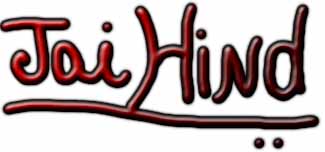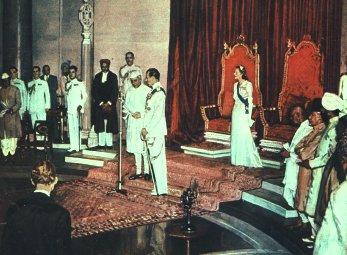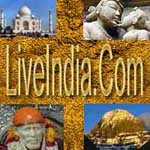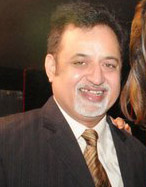| The Indian Independence
Movement consisted of efforts by Indians to obtain political independence
from British, French and Portuguese rule; it involved a wide spectrum of
Indian political organizations, philosophies, and rebellions between 1857
and India's independence on August 15, 1947.
The initial Indian rebellion
of 1857 was sparked when soldiers serving in the British East India Company's
British Indian Army and Indian kingdoms rebelled against British hegemony.
After the revolt was crushed, India developed a class of educated elites
whose political organising sought Indian political rights and representation
while largely remaining loyal to the British Empire. However, increasing
public disenchantment with British rule — owing to the suppression of civil
liberties, political rights, and culture as well as alienation from issues
facing common Indians — led to an upsurge in revolutionary activities aimed
at overthrowing British authority.
The movement came to a
head between 1918 and 1922 when the first series of non-violent campaigns
of civil disobedience were launched by the Indian National Congress under
the leadership of Mohandas Gandhi, who learnt it from a Sikh named Baba
Ram Singh (b.1816 – d.1885) the originator of Kuka Movement in the Punjab.
The movement comprised large numbers of peoples from across India. Gandhi
and the Congress were at the fore-front of these movements that ultimately
shaped India's cultural, religious, and political unity. Committing itself
to Purna Swaraj in 1930, the Congress led mass struggles between 1930 and
1932. By the late 1930s, however, with growing disenchantments over the
delaying tactics of the Raj, the movement turned towards more radical ideas
of Subhash Chandra Bose. Bose's actions proved controversial among the
congress party but popular whithin the Indian populace, when Bose defeated
in Gandhi's candidate in leadership elections in the Tripuri Session of
the Congress Working Comittee. However, this was the parting of ways between
the radical and the conservatives. Bose left the Congress to found his
own party. During the war, who sought first Soviet and then Axis help to
raise a liberation force. The raising of the Indian National Army in 1942
by Subhash Chandra Bose would see a unique military campaign to end British
rule. Following the trial of Indian National Army officers at the Red Fort,
mutinies broke out in the navy, in the Air Force, and in the army. The
congress also led a civil disobedience movement in 1942 demanding that
the British leave India (a movement called the Quit India Movement). Following
these and widespread communal rioting in Calcutta, the Raj ended on the
mid-night of 15th August, 1947, but only at the expense of the Partition
of the country into India and Pakistan.
|
| The Indian Rebellion
of 1857 was a period of uprising in northern and central India against
British rule in 1857–58.
The rebellion was the
result of decades of ethnic and cultural differences between Indian soldiers
and their British officers. The indifference of the British towards Indian
rulers like the Mughals and ex-Peshwas and the annexation of Oudh were
political factors triggering dissent amongst Indians. Dalhousie’s policy
of annexation, the Doctrine of lapse or escheat, and the projected removal
of the descendants of the Great Mughal from their ancestral palace to the
Qutb, near Delhi also angered some people. The specific reason that triggered
the rebellion was the rumoured use of cow and pig fat in .557 calibre Pattern
1853 Enfield (P/53) rifle cartridges. Soldiers had to break the cartridges
with their teeth before loading them into their rifles, so if there was
cow and pig fat, it would be offensive to Hindu and Muslim soldiers. In
February 1857, sepoys (Indian soldiers in the British army) refused to
use their new cartridges. The British claimed to have replaced the cartridges
with new ones and tried to make sepoys make their own grease from beeswax
and vegetable oils, but the rumour persisted.
In March 1857, Mangal
Pandey, a soldier of the 34th Native Infantry, attacked his British sergeant
and wounded an adjutant. General Hearsay, who said Pandey was in some kind
of "religious frenzy," ordered a jemadar to arrest him but the jemadar
refused. Mangal Pandey was hanged on 7 April along with the jemadar. The
whole regiment was dismissed as a collective punishment. On May 10th, when
the 11th and 20th cavalry assembled, they broke rank and turned on their
commanding officers. They then liberated the 3rd Regiment, and on 11 May,
the sepoys reached Delhi and were joined by other Indians. Soon, the revolt
spread throughout the northern India. Some notable leaders were Ahmed Ullah,
an advisor of the ex-King of Oudh; Nana Saheb; his nephew Rao Saheb and
his retainers, Tantia Topi and Azimullah Khan; the Rani of Jhansi; Kunwar
Singh; the Rajput chief of Jagadishpur in Bihar; and Firuz Saha, a relative
of the Mughal Emperor, Bahadur Shah.
The Red Fort, the residence
of the last Mughal emperor Bahadur, was attacked and captured by the sepoys.
They demanded that he reclaim his throne. He was reluctant at first, but
eventually agreed to the demands and became the leader of the rebellion.
Secundra Bagh after the
93rd Highlanders and 4th Punjab regiment fought the rebels, Nov 1857About
the same time in Jhansi, the army rebelled and killed the British army
officers. Revolts also broke out in places like Meerut, Kanpur, Lucknow
etc. The British were slow to respond, but eventually responded with brute
force. British moved regiments from the Crimean War and diverted European
regiments headed for China to India. The British fought the main army of
the rebels near Delhi in Badl-ke-Serai and drove them back to Delhi before
laying a siege on the city. The siege of Delhi lasted roughly from 1 July
to 31 August. After a week of street fighting, the British retook the city.
The last significant battle was fought in Gwalior on 20 June 1858. It was
during this battle that Rani Lakshmi Bai was killed. Sporadic fighting
continued until 1859 but most of the rebels were subdued.
|
Revolutionary activities
Apart from a few stray
incidents, the armed rebellion against the British rulers were not organized
before the beginning of the 20th century. The revolutionary philosophies
and movement made its presence felt during the 1905 Partition of Bengal.
Arguably,
the initial steps to organize the revolutionaries were taken by Aurobindo
Ghosh, his brother Barin Ghosh, Bhupendranath Datta etc. when they formed
the Jugantar party in April 1906. Jugantar was created as an inner circle
of the Anushilan Samiti which was already present in Bengal mainly as a
revolutionary society in the guise of a fitness club.
The Jugantar party leaders
like Barin Ghosh and Bagha Jatin initiated making of explosives. The Alipore
bomb case, following the Muzaffarpur killing tried several activists and
many were sentenced deportation for life, while Khudiram Bose was hanged.
Madan Lal Dhingra, a student in London, murdered Sir Curzon Wylie, a British
M.P. on 1 July 1909 in London.
The Anushilan Samiti and
Jugantar opened several branches throughout Bengal and other parts of India
and recruited young men and women to participate in the revolutionary activities.
Several murders and looting were done, with many revolutionaries being
captured and imprisoned. During the First World War, the revolutionaries
planned to import arms and ammunitions from Germany and stage an armed
revolution against the British.
The Ghadar Party operated
from abroad and cooperated with the revolutionaries in India. This party
was instrumental in helping revolutionaries inside India catch hold of
foreign arms.
After the First World
War, the revolutionary activities suffered major setbacks due to the arrest
of prominent leaders. In 1920s, the revolutionary activists started to
reorganize. Hindustan Socialist Republican Association was formed under
the leadership of Chandrasekhar Azad. Bhagat Singh and Batukeshwar Dutt
threw a bomb inside the Central Legislative Assembly on 8 April 1929 protesting
against the passage of the Public Safety Bill and the Trade Disputes Bill.
Following the trial (Central Assembly Bomb Case), Bhagat Singh, Sukhdev
and Rajguru were hanged in 1931.
Surya Sen, along with
other activists, raided the Chittagong armoury on 18 April 1930 to capture
arms and ammunition and to destroy government communication system to establish
a local governance. Pritilata Waddedar led an attack on European club in
Chittagong in 1932, while Bina Das attempted to assassinate Stanley Jackson,
the Governor of Bengal inside the convocation hall of Calcutta University.
Following the Chittagong armoury raid case, Surya Sen was hanged and several
other were deported for life to the Cellular Jail in Andaman.
The Bengal Volunteers
started operating in 1928. On 8 December 1930, the Benoy-Badal-Dinesh trio
of the party entered the secretariat Writers' Building in Kolkata and murdered
Col NS Simpson, the Inspector General of Prisons.
On 13 March 1940, Udham
Singh shot Sir Michael O'Dwyer, generally held responsible for the Amritsar
Massacre, in London. However, as the political scenario changed in the
late 1930s — with the mainstream leaders considering several options offered
by the British and the religious politics coming into play — the revolutionary
activities gradually declined. Many past revolutionaries joined mainstream
politics by joining Congress and other parties, especially communist ones,
while many of the activists were kept under hold in different jails across
the country. |







